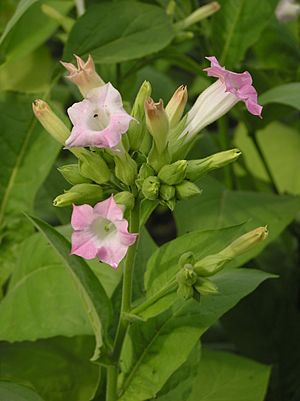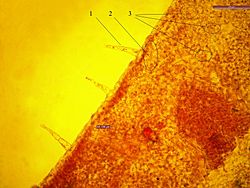Cultivated tobacco facts for kids
Quick facts for kids Cultivated tobacco |
|
|---|---|
 |
|
| Scientific classification | |
| Genus: |
Nicotiana
|
| Species: |
tabacum
|
Nicotiana tabacum, also known as cultivated tobacco, is a plant that grows every year. It's a type of herbaceous plant, meaning it has soft stems, not woody ones. You can find it growing in many places around the world. It's the most common plant grown from the Nicotiana family. People grow its leaves to make tobacco products. This plant can grow quite tall, usually between 1 and 2 meters (about 3 to 6 feet). Scientists are still studying its family tree, but they believe it's a mix of a few wild Nicotiana species, like Nicotiana sylvestris and Nicotiana tomentosiformis.
Contents
History of the Tobacco Plant
The tobacco plant first came from the Caribbean islands. The Arawak and Taino people were the first to use and grow it.
In 1560, a French ambassador named Jean Nicot brought tobacco seeds and leaves to the French court. He thought it was a "wonder drug" that could cure many things. Later, in 1586, a botanist named Jaques Dalechamps gave the plant the name Herba nicotiana. This name was also used by Linné, a famous scientist.
At first, people thought tobacco was just a pretty plant to look at. Then, they believed it was a cure-all medicine. After that, it became popular for sniffing (snuff) and smoking. Tobacco arrived in Africa in the early 1600s. For a long time, up until the early 1900s, people even used liquid from tobacco leaves to control pests on other plants.
Where Tobacco Grows and How It Lives
N. tabacum originally comes from warm, tropical and subtropical parts of America. But today, people grow it for business all over the world. Other types of tobacco plants are grown as decorative plants or sometimes pop up as weeds.
The tobacco plant needs specific conditions to grow well. It's sensitive to how warm it is, how much moisture is in the air and ground, and what kind of soil it's in. The best temperature for it to grow is between 20 and 30 degrees Celsius (68-86°F). It also likes the air to be quite humid (80-85%) and soil that doesn't have too much nitrogen.
Pests That Affect Tobacco Plants
The potato tuber moth (Phthorimaea operculella) is an insect that really likes to eat plants from the Solanaceae family, which includes tobacco. Female moths lay their eggs on the tobacco leaves. When the eggs hatch, the tiny larvae (baby insects) start eating the inside of the leaf.
What the Tobacco Plant Looks Like
Leaves
Parts of the Plant Used
Almost every part of the tobacco plant, except the seeds, contains a substance called nicotine. The amount of nicotine can change depending on the type of plant, the soil, how it's grown, and the weather. Older plants usually have more nicotine. Tobacco leaves typically have between 2% and 8% nicotine.
In a full-grown plant, most of the nicotine is in the leaves (about 64%). Some is in the stem (18%), the root (13%), and a small amount in the flowers (5%).
Traditional Uses of Tobacco
People in different parts of the world have historically used the tobacco plant for various traditional purposes:
- Brazil: People would drink juice from the leaves to help with upset stomachs.
- Colombia: Fresh leaves were used on boils and infected cuts. They also mixed crushed leaves with palm oil for hair treatment.
- Cuba: Leaf extract was taken to help with menstrual pain.
- Ecuador: Leaf juice was used for feeling unwell, chills, snake bites, and lung problems.
- Mexico (south-eastern): The ancient Maya people thought Nicotiana was a special, sacred plant. They used it for spiritual practices and for healing. Even today, the Tzeltal and Tzotzil Maya people in Mexico still use tobacco in their traditions and for remedies. They see the whole plant as a powerful helper. They might use whole leaves alone or with other herbs to make plasters or teas. A common way they use it is by grinding fresh leaves with lime to make a special snuff.
Main Ways Tobacco is Used Today
All parts of the tobacco plant contain nicotine, which can be taken out and used as a natural insecticide (bug killer). The dried leaves can also be used for this purpose and stay effective for about six months. Rubbing the juice from the leaves on your skin can also help keep insects away.
Historically, dried tobacco leaves were chewed or used as snuff (a powder sniffed into the nose). They were also smoked. Today, this plant is the main type used to make cigarettes, cigars, and other products that people smoke. The seeds of the plant can also be used to get a special oil that dries.
Drying and Preparing Tobacco
After tobacco plants are picked, they go through a process called curing (drying). Then, they are aged to make them taste better. There are four main ways to cure tobacco: air curing, fire curing, flue curing, and sun curing. The method used depends on the type of tobacco and what it will be used for.
- Air curing: Tobacco is hung in a barn where wind and sun can't reach it. It dries naturally in the air for six to eight weeks. Air-cured tobacco has low sugar but high nicotine. This method is used for cigar and burley tobaccos.
- Fire curing: Smoke from a slow-burning fire on the barn floor goes through the leaves. This gives the tobacco a unique smoky smell and taste. Fire curing takes three to ten weeks. This tobacco also has low sugar and high nicotine. It's used for pipe tobacco, chewing tobacco, and snuff.
- Flue curing: Tobacco is in a closed barn heated by hot air pipes. The tobacco doesn't touch the smoke directly. This method makes cigarette tobacco that is high in sugar and has medium to high nicotine. It's the fastest way to cure, taking about a week. Virginia tobacco cured this way is called bright tobacco because it turns gold, orange, or yellow.
- Sun curing: Tobacco dries outside in the sun. This method is used in countries like Greece and Turkey for oriental tobacco. Sun-cured tobacco is low in both sugar and nicotine and is used in cigarettes.
Once the tobacco is cured, workers tie it into small bundles called "hands" (about 20 leaves). Or, machines can make large blocks called "bales." These bundles or bales are then aged for one to three years. This aging process helps improve the flavor and makes the tobacco less bitter.
Gallery
See also
 In Spanish: Nicotiana tabacum para niños
In Spanish: Nicotiana tabacum para niños










